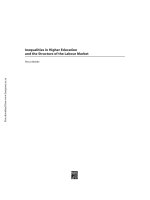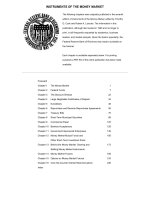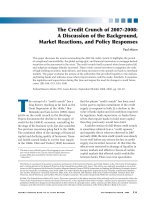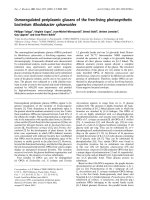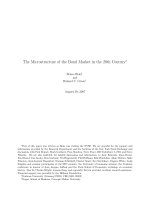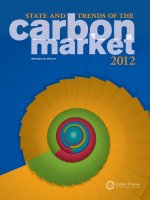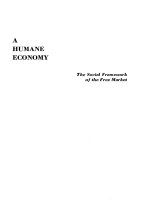algora, myths of the free market
Bạn đang xem bản rút gọn của tài liệu. Xem và tải ngay bản đầy đủ của tài liệu tại đây (1.46 MB, 277 trang )
MYTHS OF THE FREE MARKET
MYTHS OF THE FREE MARKET
Kenneth S. Friedman
Algora Publishing
New York
© 2003 by Algora Publishing.
All Rights Reserved.
www.algora.com
No portion of this book (beyond what is permitted by
Sections 107 or 108 of the United States Copyright Act of 1976)
may be reproduced by any process, stored in a retrieval system,
or transmitted in any form, or by any means, without the
express written permission of the publisher.
ISBN: 0-87586-223-3 (softcover)
ISBN: 0-87586-224-1 (hardcover)
Library of Congress Cataloging-in-Publication Data
Friedman, Kenneth S.
Myths of the free market / Kenneth Friedman.
p. cm.
Includes bibliographical references and index.
ISBN 0-87586-223-3 (softcover) — ISBN 0-87586-224-1 (hardcover)
1. Free enterprise—Social aspects. I. Title.
HB95.F738 2003
330.12'2—dc21
2003003573
Printed in the United States
TABLE
OF CONTENTS
Preface 1
Blind Faith 1
I. ECONOMY 9
1. T
HE POVERTY OF LAISSEZ FAIRE — THE EVIDENCE 11
Laissez Faire Has Not Worked 11
Early Symptoms of Economic Decline 17
2. L
AISSEZ FAIRE — IT CAN’T POSSIBLY WORK 25
Laissez Faire Cannot Maximize Wealth 25
Do We Want What Laissez Faire Promises? 29
3. D
ECLINE AND DISASTER 37
History: The Effects of Economic Inequality 37
Decline 37
Disaster 40
Wealth and Taxes 48
4. T
HE SPAWN OF “LAISSEZ FAIRE” 53
Institutional Incubi 53
Short-Term vs. Long-Term Investment Horizons 54
Credit Overload 56
Mutual Funds and Corporate Management 58
Trade 64
Free Trade vs. Mercantilism 66
5. W
HY WE FALL FOR LAISSEZ FAIRE 69
Mythology of Early Laissez Faire 69
Laissez Faire and Our Present Interests 75
6. T
HE VIRTUAL REALITY OF CLASSICAL ECONOMICS 79
Economics: Theory vs. Reality 79
Ebullient Markets — Dangerous Economy 93
VII
7. A NEW ECONOMIC PARADIGM 99
An Alternative Approach 99
Nonlinear Thermodynamics and Economics 105
A
PPENDIX 115
Nonlinear Economics 115
POLITY 121
Values, Science, Reason 123
1. H
UMANISM 129
The Propriety of Humanism 129
“Strict Constructionist” as a Label 133
The Focus of Humanism 136
Individuals vs. Classes 141
2. H
UMANISM AND GOVERNMENT 151
A Humanistic Rationale for Government 151
Curbing Excessive Power 158
3. R
EJECTING LIBERALISM 169
Freedom, Rights, and Libertarianism 171
Libertarianism and the Relativity of Values 177
4. D
EMOCRACY 185
Do We (Should We) Have a Democracy? 185
Do We? 185
Should We? 194
Democracy vs. Laissez Faire 199
Is Local Government the Answer? 202
5. P
REREQUISITIES TO FUNCTIONAL DEMOCRACY 207
Masses vs. Elites 207
6. T
HE CRITICAL ROLE OF EDUCATION 217
Ultimate R&D: Education 217
Education and the Foundations of Democracy 229
FINALITY? 235
Denouement 237
The Free Market vs. The Environment 237
R
EFERENCES 249
I
NDEX OF NAMES 255
I
NDEX OF TERMS 259
I
NDEX OF US CORPORATIONS 263
VIII
To my wife, Janet.
Courage to never give up.
What a role model!
Refutable self-serving lies
Cause misery untold.
Dire poverty destroys the lives
Of millions in your fold!
America! America!
Your dream has gone astray.
It serves the rich and powerful
But casts the rest away!
Acknowledgements
There is a widespread belief that until we attain some pre-ordained age we
are completely malleable. After this we cure like cement and change only mar-
ginally as we age. While I believe this notion may be true in a broad context, it is
no more than a very rough approximation. I have been fortunate to experience
formative influences well after I should have cured.
One of the most important of these was the attitude of the MIT graduate
department of philosophy, which regarded students as partners in a creative en-
deavor, rather than passive receptacles for information. Dealing with the obliga-
tions of being a partner has contributed enormously to my personal and intellec-
tual development. I now seek to add value to relationships, both in teaching and
in the business world, by structuring them as partnerships.
As a student I benefited enormously from studying with Imre Lakatos, Sir
Karl Popper, Ilya Prigogine, Abner Shimony, Huston Smith and Laszlo Tisza. It
was less the subject matter they taught and more their high standards — both
personal and professional — that served as role models. I strive to emulate them
in my own life.
Finally, I would like to thank the American Council of Learned Societies
for a fellowship in 1973 that enabled me to spend a year at the Université Libre
de Bruxelles and study nonlinear thermodynamics with Ilya Prigogine. The
seeds planted that year have been slow to germinate. The fruit is finally reflected
in parts of this book. I hope it proves to be nourishing.
Kenneth Friedman
1
PREFACE
BLIND FAITH
The gap between rich and poor is now the widest in US history. This is
disturbing, for if history is any guide we have unwittingly placed ourselves in
grave danger.
Over the last millennium Europe has witnessed long cycles of widening and
narrowing economic disparity. In each cycle, once the gap between the rich and
the rest widened beyond a certain point, it presaged decline and disaster for all
of society, the rich as well as the poor. Could we be seeing the first tremors of a
new cycle, the outliers of the next menacing storm? In recent decades, many US
citizens have come under increasing financial pressure. Since the 1970s, our
number of working poor has increased sharply. Nearly all of our much-vaunted
newly-created wealth has gone to the richest.
Law enforcement has been unable to cope with burgeoning drug use at all
levels of society. Television and radio casually air sexually explicit programs that
would have been rejected in disgust by previous generations. Sexually
transmitted diseases have become pandemic. (The number of people in the U.S.
infected with genital herpes now stands at 45 million and is increasing at the
rate of 1 million per year.) These developments have fed a widespread perception
of irresponsibility and increasing licentiousness.
Children today spend more time than ever in front of television sets or
video games. They spend less with books, peers or parents. Where are they
learning their values? What are the values they are learning?
Myths of the Free Market
2
The alienation of large groups of people has led to private militias and to an
increase in violence that has become pervasive. With 60,000 incidents of
workplace violence per year, “going postal” is part of our vocabulary. “Road rage”
is another new expression and a measure of increasing violence by “normal”
people. Since 1980 our prison population has increased five-fold.
These developments have exacerbated a polarization between a new
evangelical Christian revival and those who are distrustful of religious
dogmatism but have no solutions to the very real problems the evangelicals are
addressing. Could these trends be harbingers of something more ominous, a
more violent fracturing of society?
For a country that has prided itself on its resourcefulness, the inability to
address such problems suggests something deeper at work. There is something,
powerful but insidious, that blinds us to the causes of these problems and
undermines our ability to respond. That something is a set of beliefs, comparable
to religious beliefs in earlier ages, about the nature of economies and societies.
These beliefs imply the impropriety of government intervention either in social
contexts (libertarianism) or in economic affairs (laissez faire).
The faithful unquestioningly embrace the credo that the doctrine of non-
intervention has generated our most venerated institutions: our democracy, the
best possible political system; and our free market economy, the best possible
economic system. But despite our devotion to the dogmas that libertarianism
and free market economics are the foundation of all that we cherish most deeply,
they have failed us and are responsible for our present malaise.
The pieties of libertarianism and free markets sound pretty, but they
cannot withstand even a cursory inspection. Libertarianism does not support
democracy; taken to an extreme, it entails the law of the jungle. If government
never interferes, we could all get away with murder. Alternatively, if the
libertarian position is not to be taken to an extreme, where should it stop? What
is the difference between no government and minimal government? Attempts to
justify libertarianism, even a less than extreme position, have failed.
Laissez faire, or free market economics, characterized by minimal or no
government intervention, has a history that is long but undistinguished. Just as
the negative effects of a high fever do not certify the health benefits of the
opposite extreme, hypothermia, the dismal failure of communism, seeking
complete government control of the economy, does not certify the economic
benefits of the opposite extreme, total economic non-intervention.
Preface
3
It may seem odd, given the parabolic arc of our financial markets and the
swelling chorus of paeans to free market economics, but despite the important
role of the market, purer free market economies have consistently
underperformed well-focused mixed economies. In the latter part of the
nineteenth century the mixed economies of Meiji Japan and Bismarck’s Germany
clearly outperformed the free market economies of Britain and France. Our own
economy grew faster when we abandoned the laissez faire of the 1920s and early
1930s for the proto-socialist policies of Franklin D. Roosevelt. It has become
increasingly sluggish as we have moved back to a purer free market. Data of the
past few decades show that our GNP and productivity growth have lagged those
of our trading partners, who have mixed economies characterized by moderate
government intervention.
The persistently mediocre track record of laissez faire casts doubt on the
claim that an economy free from government interference invariably maximizes
the wealth of society. In fact, there are sound reasons the pure free market must
underperform well-focused mixed economies.
But despite laissez faire’s mediocre track record and despite powerful
arguments that it cannot possibly provide what it promises, the notion of the
unqualified benefit of the free market has become deeply embedded in our
mythology. Apologists have exulted in claims that glorify free market mythology
at the expense of reality, and also at the expense of society. Free market
principles, even though they have failed in economics, have been eagerly applied
to sectors ranging from politics to education, where they have contributed to
societal dysfunction.
One politically popular myth, that free market economics and government
non-intervention provide the basis for true democracy, flies in the face of history.
The first democrats, the classical Athenians, had a word for the ideal free
marketer, the homo economicus, working for his own economic gain but
unconcerned with the community. It was not particularly complimentary, the
ancestor of our word “idiot.” Pericles expressed the sentiment underlying this:
“We regard the citizen who takes no part in these [public] duties not as
unambitious but as useless…”
We have ignored the ramifications of this as we remodeled our pantheon.
We have replaced the notion of public-spirited citizens interested in the
common weal, a vital part of democratic thought from ancient Athens to our
founding fathers, by the invisible hand of the free market. This promises to
maximize benefit for society, if only we will be idiots.
Myths of the Free Market
4
In so far as it fails to value disinterested public spirit, free market doctrine
only pretends to cherish democracy. Let the people concentrate on their
economic gain while their leaders rule in any manner they choose. The Peoples’
Republic of China instituted free market reforms to sustain its autocratic
political regime. Augusto Pinochet brutally repressed even mild political dissent
while pursuing free market economic policies in Chile.
The reality of our own political power structure is that despite the primacy
of our financial markets and our contemporary rituals of democracy, powerful
corporations, unions and special interest groups fund political campaigns and
exact repayment in the form of enormous influence on legislation. Our
government is responsive primarily to these organizations, rather than to
citizens. This resembles the corporatism of Mussolini’s Italy more closely than
any historic democracy. We are blind to the connection between corporatism
and the lack of public interest in politics and in the common good.
In our enthusiasm for the dogma that any government interference is
necessarily bad, we forget it was government action that ended child labor. It
was government action that outlawed slavery, despite its profitability. It was
government action that ended the Great Depression, after years of failure of non-
intervention. It was government action that curbed the most virulent
expressions of racism, that provided an education for the great majority, that
created a large stable middle class. The free market did not achieve any of these
goods, and there is no indication that it ever would have done so.
This is not meant to imply that everything government does is beneficial.
But to start from the faith that everything government does is necessarily
harmful not only disregards history; it sacrifices the ability, and even the
interest, to distinguish between the beneficial and the harmful.
Just as the value of government needs to be assessed independent of dogma,
the value of the free market has to be gauged in the real world. Free markets
provide incentives for innovation. They enforce pragmatism at the expense of
ideology. They fit production to needs and desires of consumers and they lower
the price of goods. But free markets can also cause problems. Some of these stem
from the pre-eminence of the short term. This endangers long-term prosperity.
Independently, free markets encourage an extreme concentration of wealth
that has historically destroyed the fabric of society and led to a lower standard of
living for everyone. Government intervention may be our only defense against
the natural economic forces that lead to such a concentration of wealth. But the
prevailing libertarian/laissez faire credo, even though it may be held by intelligent
Preface
5
and well-meaning individuals, blinds us to both the danger and the potential for
any response that is not generated by the free market itself. Our beliefs, despite
the sincerity with which we hold them, lead us astray.
One reason we remain so tightly bound to laissez faire is that we lack a
better economic theory. Historically, no widely accepted theory, no matter how
badly it has failed, has been replaced until a better theory was found. This book
suggests an alternative — nonlinear thermodynamics, the most general physical
theory that applies to complex open systems. Simply, economies are complex
open systems. Nonlinear thermodynamics applies to such systems. Classical
physics, the model for classical economics, does not.
Nonlinear thermodynamics, for which Ilya Prigogine won the Nobel Prize
in chemistry, explains phenomena in complex open systems of thermodynamics,
chemistry and biology. Economies are complex open systems whose
mathematical description and behavior resemble the nonlinear description and
behavior of thermodynamic, chemical and biological systems. This suggests that
economics may be understood from a nonlinear perspective. Such an
understanding would support a very different economic paradigm.
The most important difference between laissez faire and nonlinear
economics is that laissez faire assures us of a stable and benign economic
equilibrium. Should an economy be temporarily displaced from equilibrium,
natural economic forces will restore that wealth-maximizing equilibrium. By
contrast, nonlinear economics shows that the equilibrium may be unstable. If a
system is displaced sufficiently far from equilibrium, natural forces may take it
even further. This process is not necessarily benign. Historically, it has led to
disaster.
The instability of local equilibrium is common, and not only in chemistry
and biology. In economics differences in wealth, once they reach a certain point,
naturally tend to increase. In the struggle for additional wealth, pre-existing
wealth has an advantage that is often decisive. The wealthy can outbid the non-
wealthy for valuable information, for political influence, for the skills and
technologies necessary to acquire additional wealth, dominating the most
favorable technologies, products, and markets.
The rich grow richer while the poor grow poorer. This can be a dangerous
destabilizing process. Throughout history it has repeatedly led to increasing
violence and a decline in security and standards of living for all. Intervention may
be necessary to maintain proximity to equilibrium and to prevent natural forces
from destabilizing the economy.
Myths of the Free Market
6
This has ramifications for government. Laissez faire is prone to systematic
malfunction. It has not maximized wealth. In principle it is incapable of
maximizing wealth. It increases economic differences to the point that these
jeopardize the stability of society and the welfare and security of everyone. There
are circumstances in which government intervention may be appropriate, even
vital. For this reason the doctrine of absolute non-interference, so glibly
dispensed by free marketers, is pernicious. It leaves us vulnerable to the
destabilization that can be wreaked by natural economic forces. Nonlinear
economics would be an improvement.
In addition to incorporating a more appropriate physical model and
supporting a more flexible approach to the role of government, such an
alternative would fit the personal and social values that have characterized
civilized societies since ancient Athens and Confucius. For there are conditions
in which the components of nonlinear systems are mutually interdependent.
A nonlinear model with mutually interdependent components, while it is
compatible with free markets, would support a traditional democratic view of
citizens concerned with the common good. It would explain interactions among
citizens with a focus on community and responsibility. It would counterbalance
the centrifugal notions of libertine freedom and mutual independence that foster
an each-person-out-for-himself mentality that dominates modern thought. It
would provide a more viable foundation for society.
In the spirit of such a foundation, humanism provides a promising platform
from which to address societal problems. Although humanism does not pretend
to present an alternative to religion, it does address spiritual values and it is
compatible with religious teachings while avoiding dogmatism and narrow
sectarianism. It stresses the value and dignity of human life and is sensitive to
quality of life. It calls attention to our relationship to each other and emphasizes
our responsibility to take action not only to improve our own lives, but to enable
others to do the same. It takes seriously our role as stewards of the environment.
While humanism is compatible with most religions, it is not compatible
with laissez faire. This is because laissez faire implies that commitment to others, to
society and to the environment is unnecessary, even pointless. So long as each
person works to maximize his own immediate economic advantage, free market
forces will insure the greatest benefit for society. Integrity, discipline, far-sighted
action to achieve meaningful long-term goals add nothing. No wonder the
popularity of laissez faire has corroded our traditional values.
Preface
7
While the consequences of this corrosion are long term, that does not make
them less noxious. If we fail to stem the corrosion we face an unpleasant period
of economic stagnation, social decay, and increasing violence.
To those who would regard this book as alarmist, I would respond that it is
irresponsible to shout: “Stay the course!” when you see breakers on the coral
reefs dead ahead. Our country has shown great resourcefulness in times of crisis.
The surest way to cause grievous damage is to anaesthetize the public so that it
does not notice a developing crisis until it is too late. Yet we are now blithely
meandering down a path fraught with peril, heedless of the warning signs.
Evolutionary pressures have selected for a propensity to react to sudden
changes in our environment. But we ignore gradual changes, including those
produced by flaws in our political and economic institutions. Because of the time
lag before effects become manifest, we misinterpret weaknesses as strengths.
We are like a man who walks with a cane — where every day a prankster shaves
one millimeter off the bottom of his cane — and so we are convinced we are
growing taller. We are not growing taller, and the sooner we confront reality the
less painful will be the consequences.
While this book focuses on the U.S., we have become subjects of
worldwide emulation. The implications of this book do not stop at our borders,
but extend to a large and growing portion of the world.
Because we are comfortable materially, it is easy to avoid examining our
fundamental beliefs. This is perilous. As Goethe claimed (Wilhelm Meister): “We
fear nothing more than reason; we ought to fear stupidity if we understood what
is really frightful; but reason is too uncomfortable, it must be brushed aside;
whereas stupidity is merely fatal, and that can be tolerated.”
A similar sentiment is echoed by W. H. Auden:
Those who will not reason
Perish in the act;
Those who will not act
Perish for that reason.

